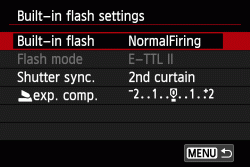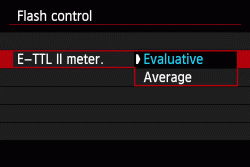The Flash does not Fire during Wireless Flash Shooting
Solution
Failure of slave flash units to fire when using wireless flash for shooting may be caused by the following problems.
- Slave units are set to a different transmission channel than the Master unit.
- Slave units are not placed properly.
In these cases, refer to the following information to check flash unit settings and placement.
REFERENCE
- In this explanation [Master] refers to the camera flash unit, and [Slave] refers to controlled wireless flash units.
- The EOS REBEL T5i / EOS 700D’s flash (Master) and Speedlite 430EX Ⅱ (Slave) have been used for the purposes of explanation.
- Use the mini stand (tripod socket provided) to prop up the slave unit.
- The position and shape of the operation buttons, and setting items may differ according to the model you use.
- For more detailed information on wireless flash photography, or control settings for the master flash unit, refer to the camera/flash instruction manual.
NOTE
Icons used on this page:
・Flash
<ZOOM/ >: Wireless setting button / <
>: Wireless setting button / < >: +/- button / <
>: +/- button / < >: Select/Setting button
>: Select/Setting button
 >: Wireless setting button / <
>: Wireless setting button / < >: +/- button / <
>: +/- button / < >: Select/Setting button
>: Select/Setting button・Camera
< ><
>< >: Cross keys / [
>: Cross keys / [  ]: Shooting tab 1 / <
]: Shooting tab 1 / < >: Setting button / <
>: Setting button / < >: Flash button
>: Flash button
 ><
>< >: Cross keys / [
>: Cross keys / [  ]: Shooting tab 1 / <
]: Shooting tab 1 / < >: Setting button / <
>: Setting button / < >: Flash button
>: Flash button1. Camera (Master) unit set-up.
Set the camera's power switch to <ON>.

2. Press the < > button to raise the built-in flash.
> button to raise the built-in flash.
 > button to raise the built-in flash.
> button to raise the built-in flash. For wireless flash shooting, be sure to raise the built-in flash.

3. Press the <MENU> button and then use the < >keys to select [Flash Control] under the [
>keys to select [Flash Control] under the [  ] tab. Then, press <
] tab. Then, press < >.
>.
 >keys to select [Flash Control] under the [
>keys to select [Flash Control] under the [  ] tab. Then, press <
] tab. Then, press < >.
>.
4. Press the < > keys to select [Built-in flash settings], then press <
> keys to select [Built-in flash settings], then press < >.
>.
 > keys to select [Built-in flash settings], then press <
> keys to select [Built-in flash settings], then press < >.
>.
5. Press the < > keys to select [Built-in flash], then press <
> keys to select [Built-in flash], then press < >.
>.
 > keys to select [Built-in flash], then press <
> keys to select [Built-in flash], then press < >.
>.
6. Press the < > keys to select [EasyWireless], then press <
> keys to select [EasyWireless], then press < >.
>.
 > keys to select [EasyWireless], then press <
> keys to select [EasyWireless], then press < >.
>.
7. Press the < > keys to select [Channel], then press <
> keys to select [Channel], then press < >.
>.
 > keys to select [Channel], then press <
> keys to select [Channel], then press < >.
>.
8. Select the transmission channel (1-4), then press < >.
>.
 >.
>.
9. External flash (Slave) unit set-up.
Set the External flash unit’s power switch to <ON>.

10. Press the <ZOOM / > button for 2 seconds. [SLAVE] will light up, and the external flash will be set to slave mode.
> button for 2 seconds. [SLAVE] will light up, and the external flash will be set to slave mode.
 > button for 2 seconds. [SLAVE] will light up, and the external flash will be set to slave mode.
> button for 2 seconds. [SLAVE] will light up, and the external flash will be set to slave mode.
11. Press the <ZOOM / > button until [CH] begins to blink.
> button until [CH] begins to blink.
 > button until [CH] begins to blink.
> button until [CH] begins to blink.
12. Press the < > button to set the slave unit to the same transmission channel as the master unit, and then press <
> button to set the slave unit to the same transmission channel as the master unit, and then press < >.
>.
 > button to set the slave unit to the same transmission channel as the master unit, and then press <
> button to set the slave unit to the same transmission channel as the master unit, and then press < >.
>.
This concludes the channel settings.
Position the camera and slave unit(s) within the range shown below.

REFERENCE
- If there is a test firing setting on the master, press the master unit’s test firing button to test-fire the slave unit. If the slave unit does not fire, adjust its angle toward the master unit and distance from the master unit.
- The above image shows the effective transmission range when the EOS REBEL T5i / EOS 700D’s built-in flash is used for wireless flash photography. The effective transmission range and angle may differ depending on the camera/flash you used as the master unit. For more information, refer to the manual that came with your camera or flash unit.
Use the bounce feature to swing the slave unit’s flash body so that the wireless sensor faces the master unit.

- Indoors, the wireless signal can also bounce off the wall so there is more leeway in positioning the slave unit(s).
- After positioning the slave unit(s), be sure to test the wireless flash operation before shooting.
- Do not place any obstacles between the master unit and slave unit(s). Obstacles can block the transmission of wireless signals.
REFERENCE
- If there is a test firing setting on the master, press the master unit’s test firing button to test-fire the slave unit. If the slave unit does not fire, adjust its angle toward the master unit and distance from the master unit.
The following section provides an overview of the basic and easy full-automatic wireless flash shooting mode.
CAUTION
- To avoid overheating and degrading the flash head, do not fire more than 20 continuous flashes. After 20 continuous flashes, allow a rest time of at least 10 min.
- If you fire more than 20 continuous flashes and then fire more flashes in short intervals, the inner overheating prevention function may be activated to make the recycling time about 8 to 20 sec. If this occurs, allow a rest time of about 15 min. and the flash will then return to normal.
- The above information on number of continuous flashes and rest times is for the Speedlite 430EX II. Depending on the flash, the number of continuous flashes and rest time may differ. Make sure to read the manuals that came with your camera and flash carefully.
1. Set the powers switches of the flash and camera to <ON>.


2. Press the <MENU> button and then use the < >keys to select [Flash Control] under the [
>keys to select [Flash Control] under the [  ] tab, and then press <
] tab, and then press < >.
>.
 >keys to select [Flash Control] under the [
>keys to select [Flash Control] under the [  ] tab, and then press <
] tab, and then press < >.
>.
3. Press the < > keys to select [E-TTL II meter.], then press <
> keys to select [E-TTL II meter.], then press < >.
>.
 > keys to select [E-TTL II meter.], then press <
> keys to select [E-TTL II meter.], then press < >.
>.
4. Press the < > keys to select [Evaluative], then press <
> keys to select [Evaluative], then press < >.
>.
 > keys to select [Evaluative], then press <
> keys to select [Evaluative], then press < >.
>.
5. Press the < > keys to select [Built-in flash settings], then press <
> keys to select [Built-in flash settings], then press < >.
>.
 > keys to select [Built-in flash settings], then press <
> keys to select [Built-in flash settings], then press < >.
>.
6. Press the < > keys to select [Built-in flash], then press <
> keys to select [Built-in flash], then press < >.
>.
 > keys to select [Built-in flash], then press <
> keys to select [Built-in flash], then press < >.
>.
7. Press the < > keys to select [EasyWireless], then press <
> keys to select [EasyWireless], then press < >.
>.
 > keys to select [EasyWireless], then press <
> keys to select [EasyWireless], then press < >.
>.
REFERENCE
- Even though the firing of the built-in flash is disabled when [EasyWireless] is set, it will still fire a small flash to control the slave unit. Depending on shooting conditions, the flash fired to control the slave unit may appear in the picture.
8. Set [Channel] for the master and slave units.
For more information, refer to step 6 of Select a Transmission Channel.9. Position the slave unit(s) within the master unit’s wireless transmission range.
For more information, refer to Position the Slave Unit(s) within Range of the Master Unit.Aim the Slave Unit’s Receiver at the Master Unit.
10. Check that the flash is ready.
When the slave unit(s) is ready to fire (fully charged), the AF-assist beam will blink at 1-sec. intervals.

11. Set the camera in the same way as with normal flash shooting.
12. To exit wireless flash shooting, select [NormalFiring] for [Built-in flash].









